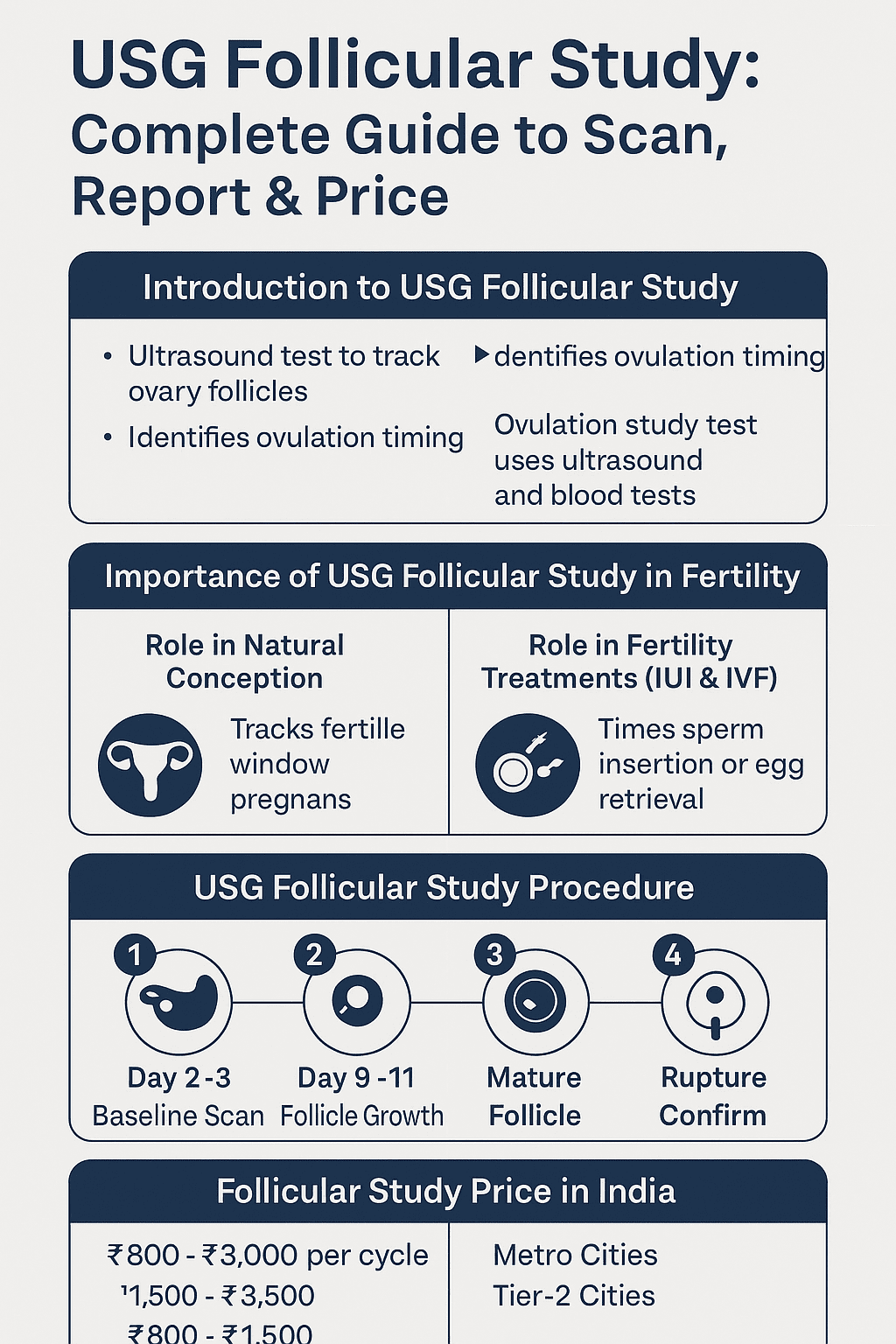Table of Contents
ToggleIntroduction to USG Follicular Study
When couples face challenges in conceiving, one of the first fertility tests recommended is the USG follicular study. Also called a follicular study scan, it is a series of ultrasound tests that track the growth and rupture of ovarian follicles during a woman’s menstrual cycle.
By examining the follicular study report, doctors can pinpoint the exact timing of ovulation—helping couples plan natural conception or assisted reproductive treatments like IUI and IVF.
Unlike hormone-based ovulation kits, a USG follicular study test provides direct and accurate imaging of the ovaries and endometrium, making it far more reliable.
What is a USG Follicular Study Test?
A USG follicular study test involves performing multiple ultrasound scans across a menstrual cycle to track:
- Follicle growth (egg maturation)
- Endometrial thickness (uterine lining)
- Ovulation (follicle rupture)
👉 Typically, 4–6 scans are needed per cycle.
Importance of USG Follicular Study in Fertility
Role in Natural Conception
For couples with irregular cycles, a USG follicular study scan identifies the fertile window with precision, improving chances of natural conception.
Role in Fertility Treatments (IUI & IVF)
- IUI (Intrauterine Insemination): Ensures sperm insertion matches egg release.
- IVF (In-Vitro Fertilization): Determines the right timing for egg retrieval, preventing premature ovulation.
👉 This makes USG follicular monitoring an essential test in all fertility clinics.
USG Follicular Study Procedure
Step-by-Step Follicular Scan Process
- Day 2–3: Baseline scan checks ovaries and uterus.
- Day 9–11: Follicle size typically grows to 12–16 mm.
- Day 12–14: Follicle matures (18–24 mm), ready for ovulation.
- After Ovulation: A final scan confirms follicle rupture and checks the uterine lining.
How Many Times is Follicular Study Done?
Usually, 4–6 scans per cycle are performed.
Follicular Monitoring Ultrasound vs. Ovulation Study
- USG Follicular Study: Tracks follicle growth and rupture only.
- Ovulation Study: May include hormone blood tests along with ultrasound.
USG Follicular Study Test Report
What a Normal Report Looks Like
- Follicle grows steadily and ruptures by Day 12–16.
- Endometrium (ET) thickness: 8–12 mm.
Follicle Size by Day (Normal Ranges)
- Day 9: 8–12 mm
- Day 10: 12–14 mm
- Day 11: 14–16 mm
- Day 12–14: 18–24 mm (mature follicle, ready for ovulation)
Abnormal Report Findings
- Follicle does not rupture (anovulation).
- Multiple small follicles (common in PCOS).
- Thin endometrium (<7 mm), lowering implantation chances.
USG Follicular Study Price in India
Average Cost of Follicular Study Test
The follicular study price in India ranges between ₹800 – ₹3,000 per cycle.
Price Comparison
- Metro Cities (Delhi, Mumbai, Bangalore): ₹1,500 – ₹3,500
- Tier-2 Cities: ₹800 – ₹1,500
Follicular Study Price vs. Other Fertility Tests
- Follicular Study Scan: ₹800 – ₹3,000
- HSG Test (tube test): ₹4,000 – ₹8,000
- AMH Blood Test: ₹1,000 – ₹2,500
👉 Clearly, the USG follicular study test price makes it one of the most affordable and effective fertility evaluations.
After Follicular Study – Next Steps in Treatment
If the Report is Normal
- Couples may try natural conception.
- Doctors may recommend timed intercourse or IUI.
If the Report is Abnormal
- Ovulation-inducing medicines like Clomiphene or Letrozole.
- Hormonal injections (FSH, hCG) to trigger ovulation.
- IVF treatment if repeated cycles fail.
👉 For a broader perspective, check our detailed guide on Follicular Study: Reports, Normal Ranges & Next Steps (internal link to pillar page).
Benefits of USG Follicular Study Test
- Accurate Ovulation Tracking: Real-time monitoring.
- Affordable: Cost-effective compared to advanced fertility tests.
- Personalized Fertility Care: Helps doctors tailor treatment plans.
Risks and Limitations of Follicular Study Scan
- Mild discomfort during transvaginal scans.
- Does not guarantee pregnancy—other infertility factors may exist.
- Emotional stress due to repeated scans.
FAQs on USG Follicular Study, Report & Price
1. What is a USG follicular study used for?
To track ovulation and identify the best time for conception.
2. How many times is follicular study done per cycle?
Usually 4–6 scans are required.
3. What is the average follicular study price in India?
₹800 – ₹3,000 per cycle.
4. What is a normal follicular study report?
Mature follicle of 18–24 mm with ET thickness of 8–12 mm.
5. Can USG follicular study guarantee pregnancy?
No, but it improves the chances by ensuring correct timing.
Conclusion
A USG follicular study is one of the most valuable and affordable fertility tests. By providing accurate insights into follicle growth, ovulation, and uterine lining, it plays a vital role in both natural conception and advanced treatments like IUI and IVF.
With its low test price and wide availability, the USG follicular study scan report is often the first step in fertility evaluation—guiding couples closer to parenthood.
